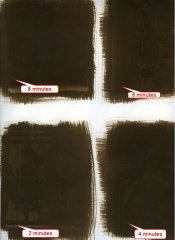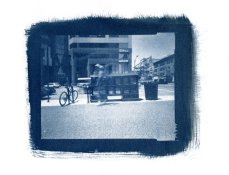ndavidson2
Member
So last June I purchased a Alt-Process starter kit from B&S, which included all the materials necessary to makes Cyanotypes and VDBs. I've made a few successful Cyanotypes during the summer and fall, and over the past few days, have attempted to make untoned VDBs, with incredibly poor results. It seems that no matter how long I expose the VDB, it's completely overexposed.
I've attached a screenshot, where I exposed 4 different 4x5's of varying contrast, and exposed each one at different intervals. I even exposed for the shortest referenced time possible (2 minutes), and still came out grossly overexposed. This scan was taken several hours after drying, and most likely would only get darker with any more dry-down.
This doesn't seem "normal" to me. I figure I can expose my next print for 30 seconds (can't attempt for another few days), but that's well below any amount of time I've seen online (I also have Christopher James' book..).
Is it possible that the sensitizer is bad? Again, I only received it in June, which would make it about 8 months old. I store it in the bathroom at room temp, where there is no UV light coming. The only thing I can think of is that when I first got the package, I opened it up in the living room, next to windows where there would have been a decent amount of UV light coming in. I had probably left it there for a few hours (maybe it was a day?) before I moved it into my bathroom/darkroom.
For reference, this was exposed via the Sun, clear Winter afternoon skies in Ohio.
I've attached a screenshot, where I exposed 4 different 4x5's of varying contrast, and exposed each one at different intervals. I even exposed for the shortest referenced time possible (2 minutes), and still came out grossly overexposed. This scan was taken several hours after drying, and most likely would only get darker with any more dry-down.
This doesn't seem "normal" to me. I figure I can expose my next print for 30 seconds (can't attempt for another few days), but that's well below any amount of time I've seen online (I also have Christopher James' book..).
Is it possible that the sensitizer is bad? Again, I only received it in June, which would make it about 8 months old. I store it in the bathroom at room temp, where there is no UV light coming. The only thing I can think of is that when I first got the package, I opened it up in the living room, next to windows where there would have been a decent amount of UV light coming in. I had probably left it there for a few hours (maybe it was a day?) before I moved it into my bathroom/darkroom.
For reference, this was exposed via the Sun, clear Winter afternoon skies in Ohio.






